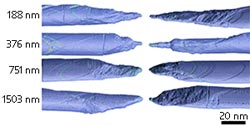Nanowires: The long and short of breaking

Examples of failure in four different lengths of nanowire as a result of tensile stress. Only nanowire sections close to the fracture are shown. A short (188 nanometer (nm)) nanowire fails through gradual, ductile deformation (top). A long (1,503 nm) nanowire fails abruptly through a brittle or localized shear failure (bottom).<br><br>© 2012 American Chemical Society<br>
Most materials will break when a force is applied to an imperfection in their structure — such as a notch or dislocation. The behavior of these imperfections, and the resulting breakage, differ markedly between small structures, such as nanowires, and larger, bulk materials.
However, scientists lacked complete understanding of the precise mechanics of nanowire breakages, owing in part to inconsistent behavior in experiments. These inconsistencies are now resolved thanks to numerical simulations by Zhaoxuan Wu and his co-workers at the A*STAR Institute for High Performance Computing, Singapore, and collaborators in the USA1.
The researchers focused on metal nanowires with a so-called 'face-centered cubic crystal structure' because they exhibit two different failure modes. Previous experiments by other groups showed that these nanowires can break as the result of a ductile process, in which a narrow neck is formed smoothly and continuously before failure. Other experiments showed that the failure was caused by a brittle fracture, which happened suddenly. To complicate matters further, atom-scale simulations of these experiments predicted that only ductile necking should be occurring.
Most materials will break when a force is applied to an imperfection in their structure — such as a notch or dislocation. The behavior of these imperfections, and the resulting breakage, differ markedly between small structures, such as nanowires, and larger, bulk materials. However, scientists lacked complete understanding of the precise mechanics of nanowire breakages, owing in part to inconsistent behavior in experiments. These inconsistencies are now resolved thanks to numerical simulations by Zhaoxuan Wu and his co-workers at the A*STAR Institute for High Performance Computing, Singapore, and collaborators in the USA (1).
The researchers focused on metal nanowires with a so-called 'face-centered cubic crystal structure' because they exhibit two different failure modes. Previous experiments by other groups showed that these nanowires can break as the result of a ductile process, in which a narrow neck is formed smoothly and continuously before failure. Other experiments showed that the failure was caused by a brittle fracture, which happened suddenly. To complicate matters further, atom-scale simulations of these experiments predicted that only ductile necking should be occurring.
The A*STAR-affiliated researchers contributing to this research are from the Institute for High Performance Computing
Journal information
Wu, Z., Zhang, Y.-W., Jhon, M. H., Gao, H. & Srolovitz, D. J. Nanowire failure: long = brittle and short = ductile. Nano Letters 12, 910–914 (2012).
Media Contact
All latest news from the category: Materials Sciences
Materials management deals with the research, development, manufacturing and processing of raw and industrial materials. Key aspects here are biological and medical issues, which play an increasingly important role in this field.
innovations-report offers in-depth articles related to the development and application of materials and the structure and properties of new materials.
Newest articles

Silicon Carbide Innovation Alliance to drive industrial-scale semiconductor work
Known for its ability to withstand extreme environments and high voltages, silicon carbide (SiC) is a semiconducting material made up of silicon and carbon atoms arranged into crystals that is…

New SPECT/CT technique shows impressive biomarker identification
…offers increased access for prostate cancer patients. A novel SPECT/CT acquisition method can accurately detect radiopharmaceutical biodistribution in a convenient manner for prostate cancer patients, opening the door for more…

How 3D printers can give robots a soft touch
Soft skin coverings and touch sensors have emerged as a promising feature for robots that are both safer and more intuitive for human interaction, but they are expensive and difficult…





















